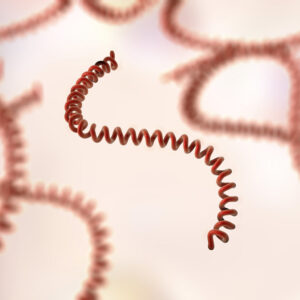Leptospira
Leptospirosis is a zoonotic disease with world-wide distribution, and is caused by Leptospira species of the pathogenic Leptospira genus, predominantly L. interrogans. They are thin, flexible, motile, spiral-shaped bacteria that have a hook-shaped end. Many species of wild and domestic animals can serve as a reservoir for these bacteria, excreting them in their urine and human infection generally results from direct contact with contaminated soil and water. Mild leptospirosis in humans is characterized by a sudden onset of headache, fever, malaise, muscle pain or prostration whereas the severe form (also known as Weil’s disease) is characterized by kidney or liver failure, hemorrhage or death. Leptospirosis is (re-) emerging globally and numerous outbreaks have occurred worldwide during the past decade.
Leptospira Background
Leptospirosis is a widespread zoonotic disease, caused by systemic infection of pathogenic spirochetes of the genus Leptospira. Leptospira was first observed in 1907 in kidney tissue slices of a leptospirosis victim who was described as having died of Yellow Fever (Stimson, 1907). Leptospires belong to the order Spirochaetales, family Leptospiraceae, genus Leptospira. They can be pathogenic (e.g. L. interrogans) or saprophytic (e.g. L. biflexa) ; pathogenic leptospires are maintained in nature in the renal tubules of animals and saprophytic leptospires are found in in wet or humid environments (Ryan & Ray, 2004). They are grouped into serovars according to their antigenic relatedness; there are currently nearly 300 recognized serovars, a few of which are found in more than one species of Leptospira, divided into 25 serogroups (Brenner et al., 1999; Bharti et al., 2003). There are seven main pathogenic species, namely L. interrogans, L. borgpetersenii, L. santarosai, L. noguchii, L. weilli, L. kirschneri and L. alexanderi (ECDC, 2017; Evangelista & Coburn, 2010). There is also a genomic Leptospira classification which includes all L. interrogans and L. biflexa serovars. The genus Leptospira is divided into 20 species classified into saprophytic, intermediate, and pathogenic groups.
Leptospira are spiral-shaped bacteria that are 6-20 μm long and 0.1 μm in diameter with a wavelength of about 0.5 μm (Levett, 2001). One or both ends of the spirochete are usually hooked and all members of the genus have similar morphology. The leptospiral genome is made up of approximately 3.9–4.6 Mbp, depending on the strain and species, and is composed of two circular chromosomes. Bacteria have a Gram-negative-like cell envelope consisting of a cytoplasmic and outer membrane. However, the peptidoglycan layer is associated with the cytoplasmic rather than the outer membrane, an arrangement that is unique to spirochetes. The two flagella of Leptospira extend from the cytoplasmic membrane at the ends of the bacterium into the periplasmic space and are necessary for the motility of Leptospira (Picardeau et al., 2001).
Pathogenic leptospires live in the kidneys of a large variety of mammalian species and are excreted into the environment with urine, and many species of wild and domestic animals can serve as a reservoir. The brown rat (Rattus norvegicus) is a reservoir for Leptospira interrogans serovars icterohaemorrhagiae and copenhageni. Cattle are the main reservoir for serovar hardjo; field mice (Microtus arvalis) and musk rats (Ondatra zibethicus) for serovar grippotyphosa. The house mouse (Crocidura russula) may be a reservoir for serovar mozdok (type 3) (WHO, 2003). Leptospirosis in livestock causes significant economic loss to farmers as infected animals suffer weight loss, poor milk production, abortion or even death. Human infection results from contact with contaminated soil or water or with the body fluid of infected animals, recreational exposure to water contaminated with urine from infected animals and following natural disasters involving flooding. Leptospira enters the body via cuts or abrasions in the skin or through mucous membranes of the eyes, nose or throat. The onset of the disease in humans is variable, ranging from 1 day to 4 weeks after exposure, and in survivors, infection can last for months (Plank & Dean, 2000). Mild leptospirosis in humans is characterized by a sudden onset of headache, fever, malaise, muscle pain or prostration. The most severe disease form is Weil’s syndrome, characterized by a multiorgan system complications, including jaundice, meningitis, pulmonary hemorrhage, hepatic and renal dysfunction, and cardiovascular collapse.
The lack of effective cross-reactive vaccines limits the potential effect of immunisation strategies in animals and humans. Additionally, the quality and availability of diagnostic tests, testing facilities and surveillance systems are very variable and frequently not available which means the rate of spread and increase of leptospirosis remains largely unknown. Novel or adapted simplified diagnostic tests, both for diagnosis in humans and animals, are urgently needed (ECDC, 2017).
References
- Bharti et al. (2003). Leptospirosis: a zoonotic disease of global importance. The Lancet Infectious Diseases. 3 (12): 757–71.
- Brenner et al. (1999). Further determination of DNA relatedness between serogroups and serovars in the family Leptospiraceae with a proposal for Leptospira alexanderi sp. nov. and four new Leptospira genomospecies. Int. J. Syst. Bacteriol. 49 (2): 839–58.
- European Centre for Disease Prevention and Control (2017). Factsheet about leptospirosis.
- Evangelista, K. V., & Coburn, J. (2010). Leptospira as an emerging pathogen: a review of its biology, pathogenesis and host immune responses. Future microbiology, 5(9), 1413–1425.
- Levett PN (2001). Leptospirosis. Clin. Microbiol. Rev. 14 (2): 296–326.
- Picardeau et al. (2001). First evidence for gene replacement in Leptospira spp. Inactivation of L. biflexa flaB results in non-motile mutants deficient in endoflagella. Mol. Microbiol. 40 (1): 189–99.
- Plank R & Dean D (2000). Overview of the epidemiology, microbiology, and pathogenesis of Leptospira spp. in humans. Microbes Infect. 2(10):1265-76.
- Ryan KJ; Ray CG, eds. (2004). Sherris Medical Microbiology (4th ed.). McGraw Hill.
- Stimson AM (1907). Note on an organism found in yellow-fever tissue. Public Health Reports. 22 (18): 541.
- World Health Organization (2003). Human leptospirosis: Guidance for diagnosis, surveillance and control.
Leptospira Antigens
The Native Antigen Company is pleased to provide a Leptospira bilexa antigen for use as a prototype antigen for the development and manufacturing of diagnostic reagents. This antigen is suitable for the detection of IgM and IgG antibodies against Leptospira species.
Leptospira Antibodies – Coming soon!
No Results Found
The page you requested could not be found. Try refining your search, or use the navigation above to locate the post.
Leptospira Immunoassays – Coming Soon!
Questions?
Check out our FAQ section for answers to the most frequently asked questions about our website and company.


